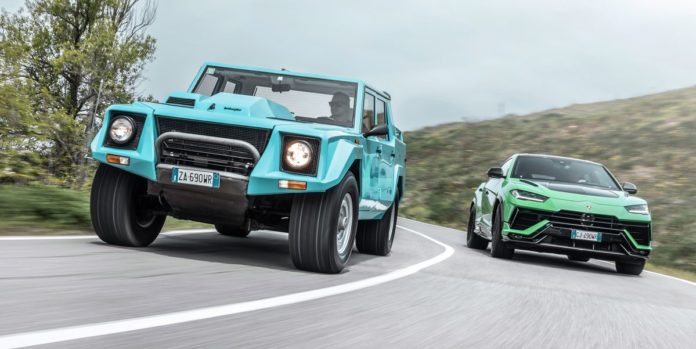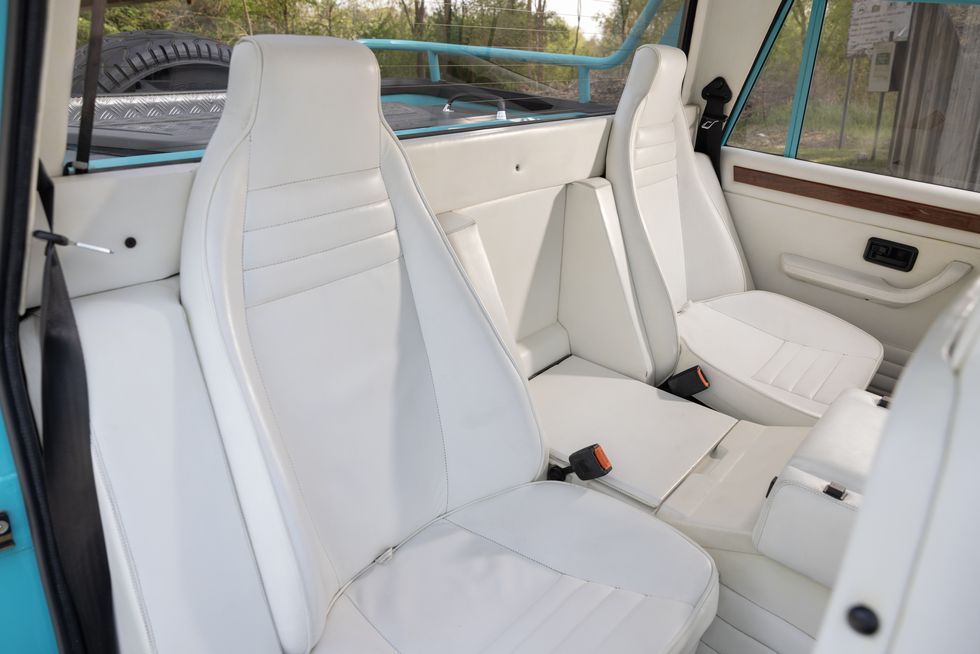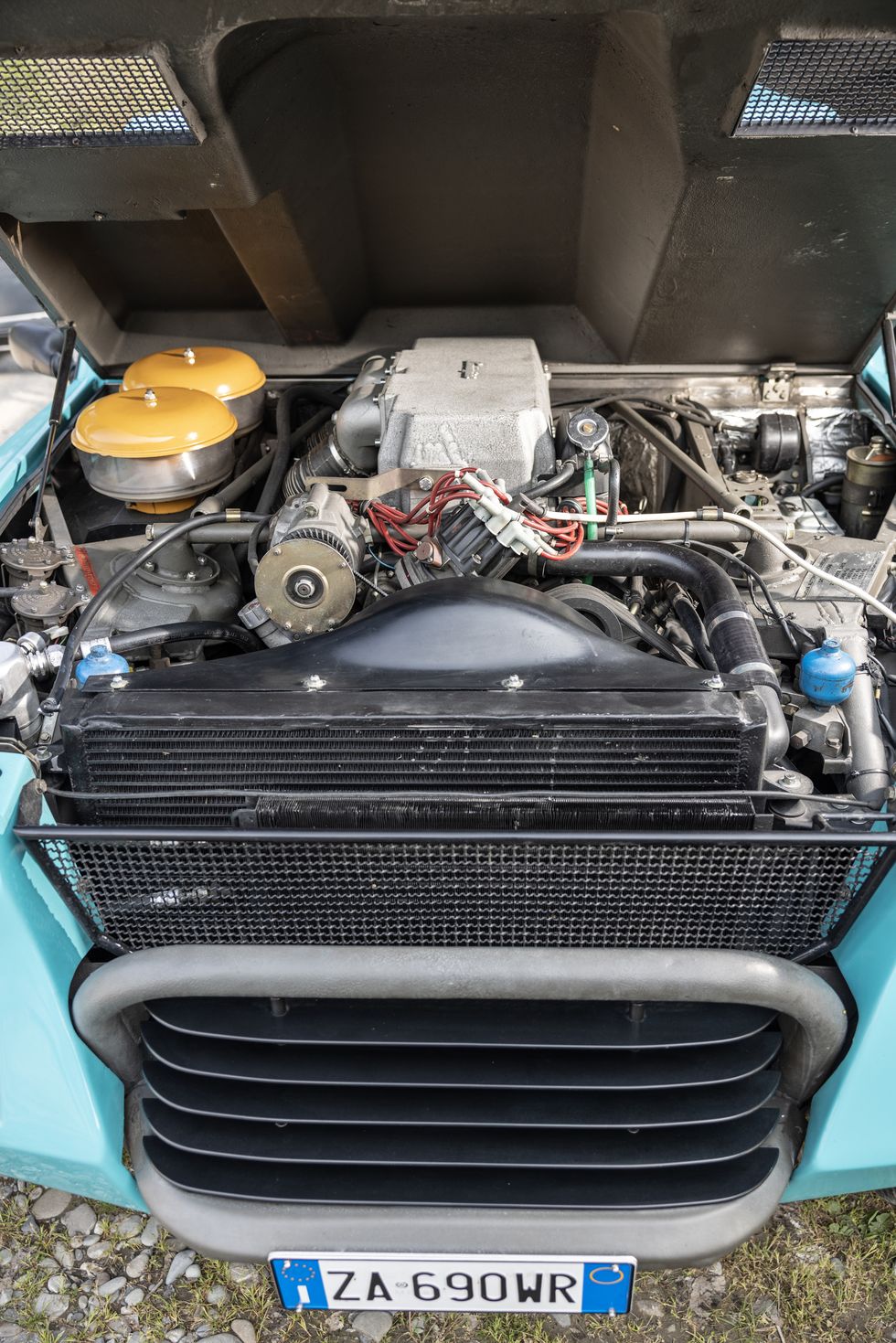From the September 2023 issue of Car and Driver.
Was any car more ahead of its time than the Lamborghini LM002?
In its day, the LM002 was a freak, an epic miscalculation by a brand that really couldn’t afford a dud. Now it looks like clairvoyance: the original exotic luxury SUV, two or three decades too early. Today almost every sports-car company builds a six-figure overpowered utility vehicle, and even the LM002’s odd-for-its-day form—four-door, short-bed pickup truck—is the default body style for America’s most popular mode of transportation. The LM002 didn’t just predict the Bentley Bentayga and the Ferrari Purosangue; it was a harbinger of the fleet of 400-plus-horsepower crew-cab pickups that are now considered practical family transportation across the land. It should have been an instant hit, the LM002. To try to find out why it wasn’t, we traveled to Lamborghini’s headquarters in Sant’Agata Bolognese to drive a 1989 LM002 alongside its spiritual successor, the 2023 Urus Performante.
Over a production run that spanned 1986 to 1992, Lamborghini built just 300 LM002s. The model was such a tough sell that we know of one customer in Florida who was told by a dealer in 1988 that he could only buy a 25th Anniversary Edition Countach if he also took an LM002 off their hands. (To his credit, he took them up on that.) These days the LM002 is so rare that to arrange a drive, Lamborghini itself must borrow one from a private owner.
This aquamarine example was commissioned by the late Japanese real-estate magnate Akira Akagi, whose company, Leyton House, fielded a 1990s Formula 1 team with cars wearing the same-colored livery. It’s an outrageous hue for an outrageous truck, one powered by a 5.2-liter Countach V-12 tuned for 444 horsepower and adapted for off-road duty. The LM002’s air intakes are routed through twin cyclonic air filters that might’ve been pilfered from some kind of Caterpillar earth-moving equipment (they’re the correct shade of yellow), while the six Weber carburetors live in a sealed aluminum sarcophagus and are adjusted by remote screws—laparoscopic surgery for air-fuel mixtures. Lamborghini says an LM002 makes less power than its Countach contemporaries thanks to the restrictive intake, a longer exhaust, and a tune that allows for the grubbiest 87-octane fuel one might find in a desert battle theater. On that front, the electrical system includes auxiliary plugs to power military equipment such as radios out in the field.
The fact that Lamborghini envisioned the LM002 as a military vehicle rather than the be-all and end-all of consumer four-by-fours is one of the great misreads in product-planning history. In the U.S., political optics dictate that we replace the Mercedes-Benz badge on humble Metris postal vans, so imagine the blowback if the Pentagon—or any other government worldwide—announced that the taxpayers were funding V-12 Lamborghinis for the armed forces. In its day, even the most brazen of oil-soaked oligarchs took a gander at the LM and said, “It’s a little much.”
Park the LM002 alongside the Urus Performante, and you can see how priorities have shifted. The LM002 was a towering truck that happened to deliver credible on-road performance—in 1987, we clocked one at 7.7 seconds to 60 mph, which was preposterously quick back when a Range Rover needed almost twice that much time. The Urus Performante is more like an extremely high-functioning sport wagon that’s happy on a racetrack but can handle dirt when the occasion arises. It trades the height-adjustable air springs of the Urus S for ground-hugging steel springs (and a 0.8-inch-lower ride height) and gains a tail-happy Rally mode for its stability-control and other software. With its twin-turbocharged 4.0-liter V-8 mustering 657 horsepower, the Performante explodes to 60 mph in 3.0 seconds. By the time it’s dispatched the quarter-mile—in 11.2 seconds at 122 mph—the Urus is traveling faster than the LM002 ever went. Lamborghini claimed a 130-mph top speed for the LM002, but the best we managed in 1987 was a doubtlessly still thrilling 118 mph.
To compare the Urus with its flamboyant predecessor, we head to the hills and trails outside Sant’Agata to find some dirt. On Italian back roads, the LM002 feels dauntingly gigantic, and it is—just look at those tires, sized 345/60VR-17. Their preposterous width was a boon for dune running, and the spare tire on the back of this one is an original sand tire, with a broad lip around the bead to increase the footprint even more when it’s aired down. (Lamborghini being Lamborghini, aesthetics surely guided the tire size, and the comic-book donuts look cool as hell.)
The LM is tall and heavy and intimidating enough behind the wheel, so imagine what it looks like from the viewpoint of an oncoming Fiat Panda. But Italians recognize a national treasure when they see it, and other drivers don’t so much yield as genuflect. Among all the weightiness of the controls—steering and throttle linkage and brake pedal—the five-speed manual shifter is surprisingly delicate and buttery in its movements. The shift lever looks like it’s wearing a leather corset, laced up along the back, making for a saucy juxtaposition with the winch controls, which reside immediately behind the shifter on the dash. (This truck doesn’t have a winch, and even Lamborghini is no longer sure which model winch is correct for an LM002.) The power windows work flawlessly, which is fortunate because the air conditioning doesn’t work at all. It possibly never did.
Given the overall insanity of the thing, it’s easy to forget that the LM002 is actually practical in a lot of ways. Like the Urus, it has four doors and back seats. Unlike the Urus, it seats six. The asterisk on that stat is that the two rearmost perches are alfresco, facing each other across the stumpy pickup bed—the world’s fanciest Subaru BRAT. This is a strictly four-passenger example, the bed filled by a fitted trunk upholstered in red carpeting. You access the bed via one of the stranger tailgates in truck history, with the entire midsection of the rear end—everything between the taillights—folding down to the ground and forming a diamond-patterned step that rests on the now-horizontal spare tire. Opening all of it up is a bit of a process, but surely you would have people for that.
Thanks to its impregnable intake plumbing, the LM002’s V-12 is relatively hushed, with the dual exhaust’s crispy cackle dominating the soundtrack. The powerplant is so quiet and torquey that it’s easy to forget this is a Countach engine, designed to rev. Peak power arrives at 6800 rpm—50 rpm higher than the Urus’s redline. Somehow pushing it that hard feels wrong. Not because this LM002 is old and valuable, but because of the cognitive dissonance of winding out to nearly 7000 rpm in a vehicle with manually locking front hubs.
A special toothed wrench engages those eight-lug hubs, but once we’re up in the hills, it’s apparent that the LM002 can go anywhere a Urus Performante can go without even engaging four-wheel drive. We venture onto dirt roads that feature the occasional washout and plenty of hikers who initially look annoyed to hear approaching traffic, then appear pleasantly bemused when they realize they’re being overtaken by a pair of Lamborghinis. Honey, you’re never going to believe what I saw in the woods today.
Picking its way down along a dry riverbed, the LM002 requires little forethought—you just think “I wanna go over there!” and then aim those 33-inch tires in whichever direction you please. The Urus, with its no-profile Pirellis, can play along, but you’re constantly running mental calculations on ground clearance and sidewall exposure to rocks. Back up on the road, the roles are reversed, and the Urus driver must heed the LM002’s pace. The Urus Performante has a chassis to match its ridiculous thrust, pulling 1.04 g’s on the skidpad and hauling down from 70 mph to a stop in 152 feet. With moves like that, it’s easy to turn the LM002 into a small turquoise dot in the rearview mirror. Both machines are authentically Lamborghini—extroverted and loud and hyperbolic—but are aimed in different directions. The LM002 would’ve been a direct hit, if its target hadn’t been decades beyond the horizon.
But who could’ve predicted a hugely popular onslaught of exotic SUVs? Well, us, actually. “We would wager that there is a stronger world demand for these monsters than one might suspect,” Brock Yates wrote in the October 1987 issue, going on to posit that Lamborghini could probably sell more of the SUVs than it does cars. In fact, last year the Urus accounted for 58 percent of Lamborghini’s overall worldwide sales, the triumph of the weirdo off-roader. You can never know what the future holds, but if school drop-off lines 30 years from now are filled with Huracán Sterrato look-alikes, remember that you heard it here first.
Specifications
Specifications
1987 Lamborghini LM002
Vehicle Type: front-engine, rear/4-wheel-drive, 4-passenger, 4-door pickup
PRICE
As Tested (C/D est, 1987): $120,000
ENGINE
DOHC 48-valve V-12, aluminum block and heads
Displacement: 315 in3, 5167 cm3
Power: 444 hp @ 6800 rpm
Torque: 368 lb-ft @ 4500 rpm
TRANSMISSION
5-speed manual
DIMENSIONS
Wheelbase: 118.1 in
Length: 192.9 in
Width: 78.7 in
Height: 72.8 in
Curb Weight: 6780 lb
C/D TEST RESULTS
60 mph: 7.7 sec
1/4-Mile: 16.0 sec @ 86 mph
100 mph: 22.8 sec
Acceleration times adhere to our old 3-mph rollout method.
Top Gear, 30–50 mph: 9.7 sec
Top Gear, 50–70 mph: 11.8 sec
Top Speed (redline ltd): 118 mph
Braking, 70–0 mph: 203 ft
C/D FUEL ECONOMY
Observed: 8 mpg
—
2023 Lamborghini Urus Performante
Vehicle Type: front-engine, all-wheel-drive, 5-passenger, 4-door wagon
PRICE
Base/As Tested: $265,971/$338,770
ENGINE
twin-turbocharged and intercooled DOHC 32-valve V-8, aluminum block and heads, direct fuel injection
Displacement: 244 in3, 3996 cm3
Power: 657 hp @ 6000 rpm
Torque: 627 lb-ft @ 2300 rpm
TRANSMISSION
8-speed automatic
DIMENSIONS
Wheelbase: 118.3 in
Length: 202.2 in
Width: 79.8 in
Height: 63.7 in
Curb Weight: 4986 lb
C/D TEST RESULTS
60 mph: 3.0 sec
100 mph: 7.2 sec
1/4-Mile: 11.2 sec @ 122 mph
130 mph: 13.1 sec
150 mph: 20.0 sec
Results above omit 1-ft rollout of 0.3 sec.
Rolling Start, 5–60 mph: 4.4 sec
Top Gear, 30–50 mph: 2.6 sec
Top Gear, 50–70 mph: 3.0 sec
Top Speed (mfr’s claim): 190 mph
Braking, 70–0 mph: 152 ft
Braking, 100–0 mph: 296 ft
Roadholding, 300-ft Skidpad: 1.04 g
C/D FUEL ECONOMY
Observed: 16 mpg
EPA FUEL ECONOMY
Combined/City/Highway: 16/14/19 mpg
C/D TESTING EXPLAINED
Senior Editor
Ezra Dyer is a Car and Driver senior editor and columnist. He’s now based in North Carolina but still remembers how to turn right. He owns a 2009 GEM e4 and once drove 206 mph. Those facts are mutually exclusive.




